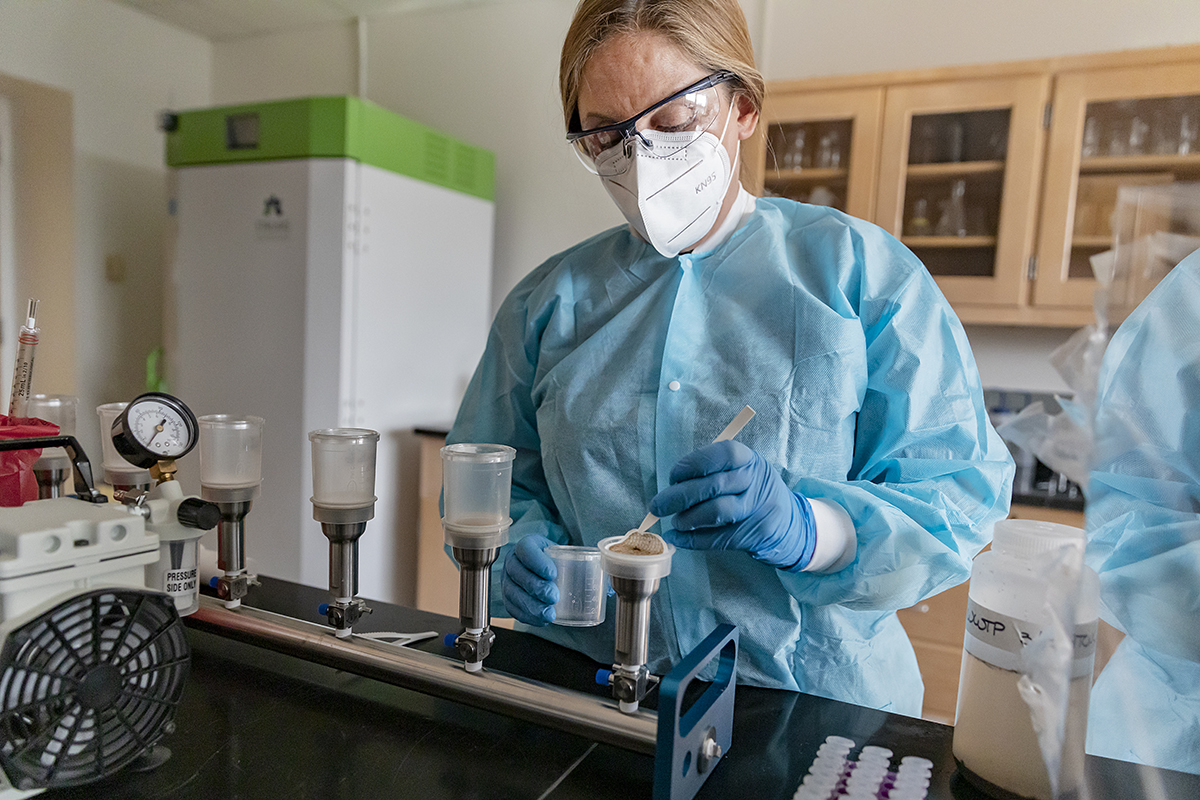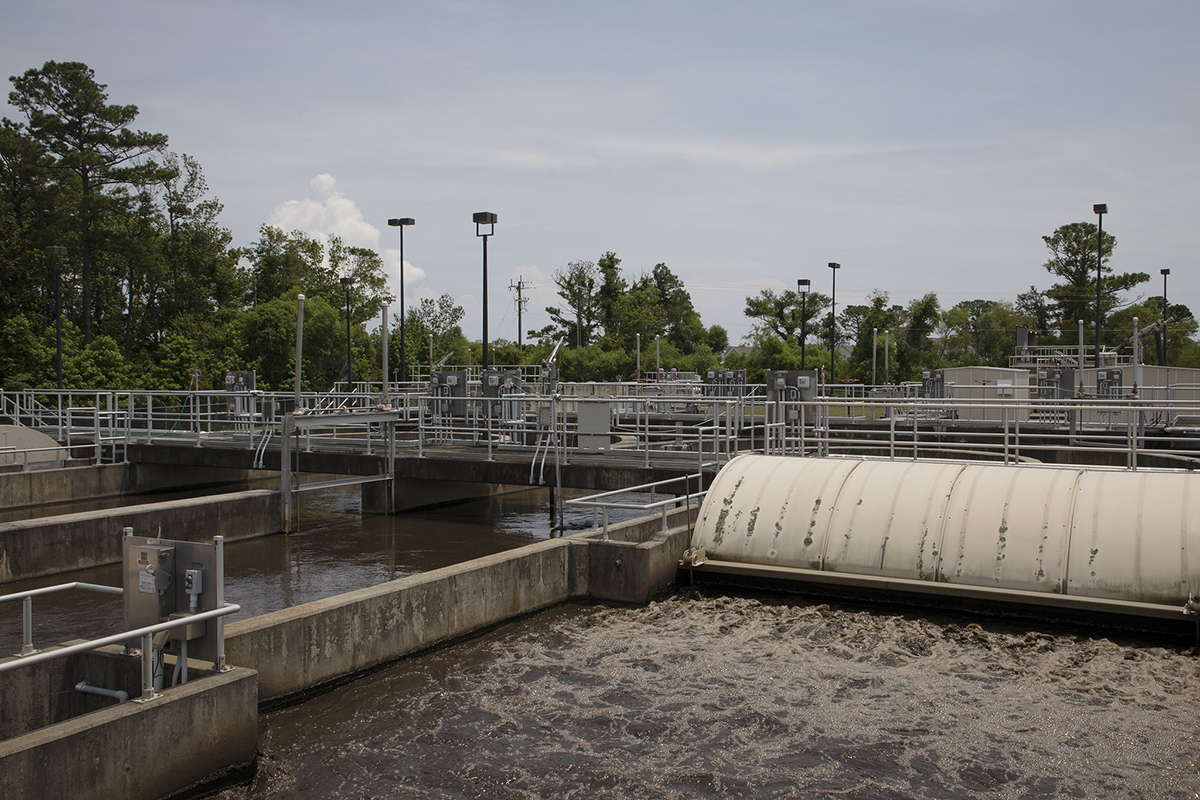
MOREHEAD CITY – Researchers here participating in a newly expanded program now have the capability through sampling and analysis of public wastewater to quickly see the emergence of COVID-19 variants of concern in specific municipalities, a potentially valuable early warning system for outbreaks as people return to schools and work settings.
“What this means is that as new variants emerge that are really dangerous — and these will happen — that might cause more severe disease or more severe numbers of hospitalizations. We’re working with a company that develops these tests as these variants circulate around the world. They’re developing the tests in real time,” said Dr. Rachel Noble, an environmental molecular microbiologist at the University of North Carolina Institute of Marine Sciences in Morehead City.
Supporter Spotlight
Noble studies pathogens in wastewater and stormwater, including SARS-CoV-2, the virus that causes COVID-19, in samples taken from public treatment facilities across the state. She said the analysists working on the wastewater monitoring project are among the top global beta testers for the new assays used to detect these emerging variants, “and we’re working very tightly with that company to do that.”
The company, Bio-Rad of Hercules, California, says that to better understand and respond to the U.K., South Africa, Brazil, California, New York or other variants, researchers need to reliably identify where they are, when they appear, and how prevalent they become over time. Each variant can be identified by the known mutations in its genomic sequence, the company says. These changes can make the virus more transmissible or difficult to treat.
The project for the North Carolina Department of Health and Human Services that began earlier this year expanded from testing 11 wastewater treatment plants in the state to 19. The department’s COVID-19 dashboard was updated Thursday with the latest results that include the new wastewater-monitoring sampling sites.
“And of those, we can see that we’ve returned to some blips, indications in the wastewater, that COVID has returned, as seen also by cases or hospitalizations in North Carolina,” Noble said.

The lab was sampling 11 sites since the inception of the program but the state was only reporting 10 on its dashboard. Now all sites are being reported on the dashboard. Other sites are expected to be added in the coming weeks.
Supporter Spotlight
Also included in the program’s expansion are new quality controls.
Earlier this summer, many of the sites being monitored had dropped to either low concentrations or nondetectable levels of the COVID-19 virus in the wastewater.
“We are definitely not in that situation currently,” she said. “We’re seeing some, what I would call blips on the radar screen in the wastewater.”
She explained that while that expansion only has been going for about four weeks now, in terms of trends where these blips on the radar screen appear in wastewater, they are generally closely followed by increases in clinical cases in those areas.
The lab in Morehead City is receiving samples from North Carolina sites twice a week for analysis. “That’s 38 total samples right now that we received, and we’re able to report that data back out to the CDC very quickly. We have a really nice turnaround on our surveillance program.”
The lab has completed variant analyses for the U.K. variant, the Delta variant and the Brazilian variant. And as variants emerge and continue to evolve, the surveillance program will serve as a warning system for those that could pose serious concern.
“It’s not perfect, but wastewater has shown itself to be a good predictor of what’s coming,” Noble said. “When someone becomes infected, just the same as with the flu or with other types of viruses, you actually start shedding the virus quite early in the infection, but you might not feel full-blown symptoms for several days.
“When a person becomes infected, they begin to contribute to the virus signal in the wastewater before they would pursue any sort of a clinical tests. Regardless of whether they’re asymptomatic, the wastewater is still picking up that virus signal.
“We are likely to see that as especially younger individuals, and by that I mean 40 and younger, that we’re likely to see numbers of individuals that are asymptomatic, that are carrying the virus but they either are completely devoid of symptoms or they have very mild symptoms and think that they just have a cold. So, that would allow the wastewater to contain the viruses that we are seeing. And those people have the capability to still shed the virus and give it to someone else, but they themselves are not seriously ill.”
This poses risks for older parents, or siblings that have not been vaccinated, she said.

Collaborative monitoring
The state announced Thursday the expansion of the sampling program to better identify areas where virus is spreading. The project is a collaboration between the North Carolina Department of Health and Human Services, University of North Carolina system researchers, wastewater utilities and public health departments.
“As the Delta variant emerges in North Carolina, it’s more important than ever for us to use all available tools to track the spread of COVID-19 so health officials and members of the public can take action if trends are increasing,” said State Epidemiologist Dr. Zack Moore said in a statement. “The recent increases we’ve seen are an important reminder that COVID-19 is still here and still a risk for people who are not fully vaccinated. If you haven’t gotten your shot, don’t wait to vaccinate.”
The Centers for Disease Control and Prevention and the U.S. Department of Health and Human Services are collaborating with various other federal agencies on the National Wastewater Surveillance System in response to the COVID-19 pandemic. The data is being used to help public health officials better understand the extent of coronavirus infections in their communities.
“I think we’re seeing that the wastewater is going to prove itself to be important as we return back to school and many people return back to the workplace,” Noble said.
The CDC says that sewage testing has been successfully used for early detection of other diseases, such as polio. But the initial sampling sites in North Carolina didn’t provide a complete picture.
“When we first designed the surveillance program, we designed it necessarily where we had partners that could do some of the sampling for us. So originally, that was Chapel Hill, Raleigh, Charlotte, Wilmington, and there were very few rural areas represented in our selection. Now that wasn’t because we were trying to ignore rural areas, it was because we were just trying to build the program,” Noble said. “Since then, we’ve added primarily rural towns, knowing that there are differences in vaccination rates between metropolitan cities and rural towns, and we are seeing trends of these emerging concentrations in wastewater in the rural towns, which is concerning.”
Trends in rural areas where sampling occurs are currently showing increases or sustained increases, as classified by the North Carolnia Wastewater Monitoring Network dashboard map updated Thursday.
With the latest data from Carteret County and New Hanover County wastewater sampling sites, levels of the virus have plateaued.
In late June, Beaufort officials announced higher levels had been detected in samples from the town’s wastewater plant. The increase appeared to correlate to an especially busy period for tourism in the county, during an already busy season.
Noble noted that the increase was not followed by an uptick in the number of clinical cases reported by the Carteret County Health Department.
“What this means for wastewater is that if you have large numbers of people in any particular city or town who are asymptomatic, they’re not getting captured in the clinical case data that’s being reported at the county level. They’re not seeking an urgent care test or an ER test because they feel fine,” she said.
There are a couple of reasons that detection trends in wastewater may not be reflected in the numbers of cases in a county.
“One is that if a tourist does have symptoms, and even if they get tested at an urgent care here, the test result is reported at their home address by DHHS,” Noble said. “The second reason is that we all know that people come to the coast to be outdoors. So even if they are carrying COVID and they’re asymptomatic, they may be unlikely to share it with other people and cause measured cases in the community because they’re out at the beach, they’re out on a boat, they’re out fishing, and they’re largely staying within their own kind of groups of friends.”
Noble said trendline peaks and valleys for communities where wastewater sampling is done is to be expected, not just here in eastern North Carolina but broadly. And as the public returns this fall to more indoor life, indications could change, possibly for the worse.
“And one way to protect yourself from that is to seek the vaccine,” she said. “A lot of people have said that they’re busy or they don’t have time.”
North Carolinians can go to MySpot.nc.gov to find a vaccine location near them.
The other way, Noble said, is that, if people are concerned about getting the vaccine, then simply wear a face mask while out in public.
“It’s not a bad thing, just wear a face mask if you’re in the grocery store,” she said.








